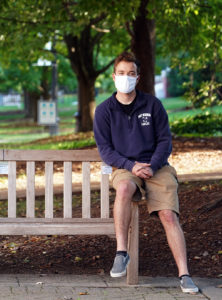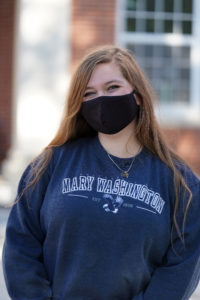Eager to begin her college career at Mary Washington, Sarah Bazemore moved into Willard Hall in September, stocking her room with masks and sanitizer.

Little did she know that she would end her first semester living in Marshall Hall under quarantine. Bazemore and two of her friends were among several dozen students who were either exposed to or came down with COVID-19 in fall 2020.
Even so, she rated the entire semester an A+. “I am so grateful I had the opportunity to be on campus this fall, and I’m beyond impressed with the way UMW handled COVID-19,” she said. “Even when we entered quarantine, there was a plan. At no time was I unable to get the support I needed or an answer to my questions.”
Only 40 students utilized the more than 100 designated quarantine/isolation rooms on campus. That, added Bazemore, “says a lot about the student body and our administration. We followed MMDC (monitor, mask, distance and clean) and did all we could to keep COVID-19 away from UMW.”
Plenty of planning and extreme vigilance paid off. While the pandemic rages across the globe, the University ended up with fewer than 50 COVID cases since the end of August.
“I’m filled with pride by the way the Mary Washington community has thus far risen to this challenge,” said President Troy Paino. “We have proven something to ourselves: We can adapt, innovate and persevere.”
And we need to prove it again, he added, noting that, though he sees a great deal of hope and promise for 2021, it is imperative that the campus community never let down its guard. Most things will remain the same – mandatory masking, a 10-person limit on gatherings, social distancing, primarily grab-n-go meals and spring course modalities much like the fall, with approximately 60 percent of courses offered online, 25 percent hybrid and 15 percent face-to-face.
While students won’t begin spring semester classes until Jan. 25, the academic calendar has been revised to include a new January 2021 term. Offered remotely from Jan. 4 to 22, this term is designed to keep students engaged and allows them to stockpile credits. Already, more than 400 students are enrolled in the 29 classes offered, ranging from Accounting 101 to The Three Big Q’s: Love, Death and Justice.
Although Spring Break has been eliminated to reduce the spread of the virus, two semester “break days” will be offered on Wednesday, March 10, and Tuesday, March 16.
Student activities proliferated last semester, moving from campus to computer. Between Aug. 24 and Dec. 11, 372 events were held, with an average of more than three events per day, said Sandrine Sutphin, director of Student Activities and Engagement. She added that this level of student engagement will continue – and even accelerate – next semester.
Students can expect to see an uptick in testing this spring as a result of increased availability and a revision in public health recommendations. New guidelines indicate the efficacy of testing asymptomatic individuals at universities. Thus, UMW plans to provide:
- Entry testing for every residential and commuter student who intends to access campus in the spring semester.
- Increased prevalence testing, which will more than double the number of such tests administered in fall 2020.
- Exit testing for students who seek it at the end of the semester.

“Nationally, many people doubted that college students could take this pandemic seriously,” said Chief of Staff and Professor Jeff McClurken, co-coordinator of UMW’s COVID return to campus plan. He and Associate Provost Tim O’Donnell lead weekly COVID implementation team meetings. “Over and over again this fall, our amazing students showed us their commitment to doing what was necessary to keep their fellow students and the faculty and staff healthy, what was necessary to keep UMW open.”
A key to the semester’s success has been those every-Wednesday meetings, with a cross-section of campus folks involved in COVID response, as well as representatives from the local health department and Mary Washington Healthcare.
“I was so impressed at how the team led during such an uncertain time to ensure a campus environment that was safe not only for the students, but also the faculty, staff and community at large,” said Christopher Newman, senior vice president and chief medical officer at Mary Washington Healthcare. “The team was able to find creative solutions to innumerable operational challenges subsequently mitigating risk while maximizing the educational experience for the students.”
Newman also gave kudos to the Mary Washington students, who – by following guidelines – helped prevent significant spread of COVID to the community.
“UMW’s COVID-19 planning was thoughtful and thorough,” said Dan Czajka, COVID-19 epidemiologist with the Rappahannock Area Health Department, adding that Mary Washington “should build upon its successes and encourage continued adherence.”

Reflecting on the semester and his experience of quarantining over Thanksgiving break, freshman Brian Veranga said: “UMW went above and beyond compared to many other universities that had poor planning or had no other choice but to send students home. I am so grateful that my university had a plan for us instead of forcing us to put our loved ones at risk.”
His friend, Ellelyshia Ardo, who also had to quarantine, said that even in the midst of a pandemic, “I was able to find new friends, have new experiences and make meaningful connections.”
Because of their favorable feelings about the experience – especially UMW’s COVID Care Coordinator Betsy Southern – Ardo, Bazemore and Veranga intend to pay it forward. They’ve signed up to serve as “buddies” next semester, checking in on fellow students who must be in quarantine or isolation.
UMW junior Kira Frazee summed up the feelings of many students: “I will be coming into the next semester with a more positive attitude. I have seen that UMW can be on campus and still be safe, and I look forward to a spring semester at my second home.”
For senior Anna Longacher’s creative take on UMW’s pandemic response, check out this video.

